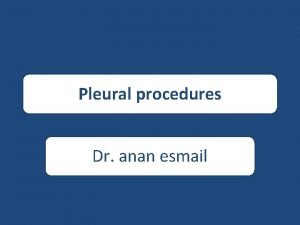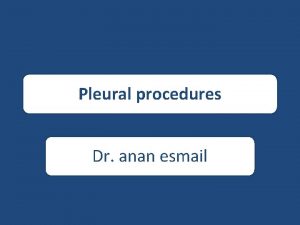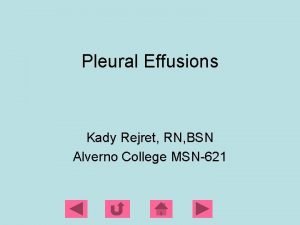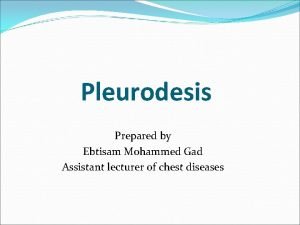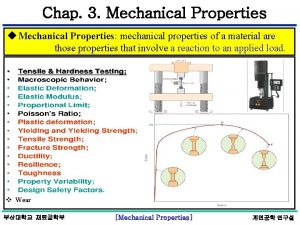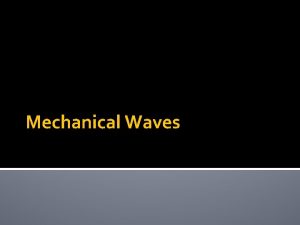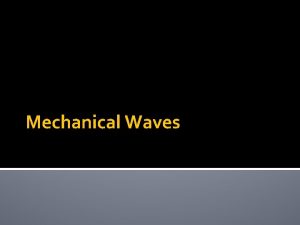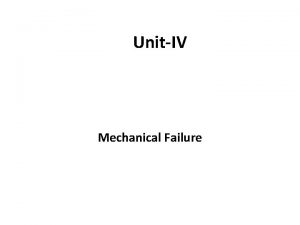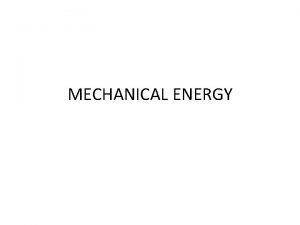Improved Instrumentation for Effective Mechanical Pleurodesis Presenter Information














- Slides: 14

Improved Instrumentation for Effective Mechanical Pleurodesis Presenter Information: Rebeccah L Brown, MD Professor of Clinical Surgery and Pediatrics Cincinnati Children’s Hospital Medical Center Cincinnati, OH

Pleurodesis Treatment Problem Statement • Patients with a pneumothorax (lung collapse) or recurring pleural effusion (accumulation of fluid in the pleural space) are commonly treated with mechanical pleurodesis - a procedure in which the parietal pleural is abraded creating an intense inflammatory response that promotes the adhesion of the visceral and parietal pleurae, effectively obliterating the pleural space, allowing the lung to fully expand • Most commonly performed thoracoscopically • Current instrumentation to achieve effective mechanical pleurodesis is limited • Improved instrumentation for performing this procedure is needed

Spontaneous Pneumothorax • • Incidence 10 -20 cases per 100, 000 people More common in males than females Usually tall, thin males < 30 years Usually associated with subpleural blebs and bullae • Most commonly treated with thoracoscopic bleb resection and mechanical pleurodesis

Pleurodesis for Refractory Pleural Effusion Allows lung to fully expand

Port Positioning for Thoracosopy

Current Instrumentation Bovie Scratch Pad

Mechanical Pleurodesis Before Pleurodesis After Pleurodesis

Pleurodesis Treatment Job: • • Mechanical pleurodesis is most often performed via thoracoscopy. Usually three ports are placed - a 12 mm port for the stapler (for associated bleb resection) and two 5 mm ports. The parietal pleura is then mechanically abraded until it is very friable and bleeding using a rough pad (usually a bovie scratch pad) held by an endoscopic grasper. Surgical removal of parietal pleura is also an effective way of achieving stable pleurodesis, however, this is less frequently performed. Problems/limitations with the procedure – – Bovie scratch pad may fracture or tear, leaving behind small fragments (foreign body) Difficult to insert bovie scratch pad through 5 mm ports, will only fit easily through 12 mm port Bovie scratch pad can easily fall off With limitations of single usable port and straight, non-articulating graspers, it is difficult to reach and abrade all surfaces effectively

Pleurodesis Treatment Outcomes: needed to improve procedure • Difficulties to overcome – No longer use bovie scratch pad or gauze pad that is difficult to insert and remove, difficult to maneuver, can fall off grasper, has small surface area, risk of foreign body retention (pieces/fibers fracture/fall off) – Inability to effectively reach pleural surfaces due to nonarticulating, non-curved instruments

Pleurodesis Treatment Constraint: • Device or procedure needs to – Fit into 5 mm port (ideally) – then all three ports could be utilized to reach more surface area – Articulate or curve to effectively reach all surfaces – Have enough rough surface area to be effective, efficient and easy to manipulate – No risk of foreign body retention or parts falling off into thoracic cavity

Concept of Articulating Scrub Head

Concept of Orthopedic Rasp-Like Instrumentation to Create Abrasion

Concept of a “Mushrooming” Head Deployed for Abrasion

Summary • Mechanical pleurodesis is frequently used to treat spontaneous pneumothorax and less commonly refractory pleural effusions • Current instrumentation to achieve effective mechanical pleurodesis is limited • The ideal instrumentation would: – – Fit in 5 mm ports Articulate Have increased rough surface area at the tip for abrasion Have no risk of foreign body/fiber retention or parts falling off into thoracic cavity
 Parietal pleura lymphatic drainage
Parietal pleura lymphatic drainage Pleurodesis
Pleurodesis Chemical pleurodesis
Chemical pleurodesis Chemical pleurodesis
Chemical pleurodesis Tenziós ptx
Tenziós ptx Actual mechanical advantage vs ideal mechanical advantage
Actual mechanical advantage vs ideal mechanical advantage Kontinuitetshantering i praktiken
Kontinuitetshantering i praktiken Novell typiska drag
Novell typiska drag Tack för att ni lyssnade bild
Tack för att ni lyssnade bild Vad står k.r.å.k.a.n för
Vad står k.r.å.k.a.n för Varför kallas perioden 1918-1939 för mellankrigstiden
Varför kallas perioden 1918-1939 för mellankrigstiden En lathund för arbete med kontinuitetshantering
En lathund för arbete med kontinuitetshantering Särskild löneskatt för pensionskostnader
Särskild löneskatt för pensionskostnader Tidbok yrkesförare
Tidbok yrkesförare Sura för anatom
Sura för anatom
